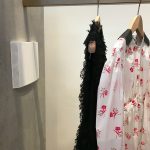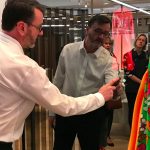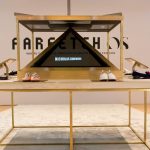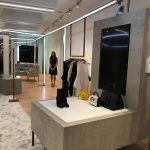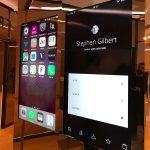Store of the future
 Your data in return for a seamless online/offline shopping experience
Your data in return for a seamless online/offline shopping experience
BY LIZA HEARON From Mashable
Here’s an idea: all the convenience of online shopping combined with the instant gratification of shopping in physical stores IRL.
This is the vision of shopping in the future, and it’s very close to a reality. All you have to do is hand over your data.
This week Mashable got a sneak peek inside a “Store of the Future” by London-based startup Farfetch, during a demonstration and conference to brands and fashionable types.
Farfetch was founded in 2008, and if you haven’t heard of it, don’t worry. It’s an e-commerce platform for luxury fashion.
But it’s been putting its pioneering platform to other uses. Not only can you get Gucci delivered straight to your door in 90 minutes in some places — soon you’ll be able to shop like a future-person (provided you have the $$$£££).
Gavin Williams, director of product development, took us through an imagined shopping experience.
So this is the scenario
A VIP shopper is on her way from New York to London. (We’ll stick with the female pronoun here, as they did.)
On the flight over, she makes a wish list of the things she wants to buy (assuming there’s Wi-Fi on the plane? A different question entirely).
This is all saved through her universal login (the key to this entire shopping experience).
When she lands in London she heads for the boutique, and checks in on her phone.
This check-in sends the wish list information over to the dedicated sales associate. It will show her which items are physically in-store, or the sales associate can recommend other items based on her tastes.
She can browse around and look at products from the smart rail, which is actually pretty neat. It uses an RFID scanner to see what she’s physically picked up and looked at, and then it sends it to her app.
This creates a Tinder-like situation where she can swipe left or right on the items she wants to try on.
When she’s ready to try on she heads over to the smart mirror. This is actually a touch screen with a variety of controls. Her selected items appear on the screen. She can then request other sizes or colours, or recall items she’s already bought to see how they look together.
She can also use controls on the mirror to change the lighting to moonlight, candlelight, daylight, etc, to see how her choices look in various settings. Neat. (This feature probably elicited the most gasps from the assembled press gaggle.)
Once she’s made her choices it’s time to pay up. This can be done entirely from the mirror, and Williams says he imagines the process in a similar way to texting back and forth.
Select the option to pay, and various different e-wallets such as Apple Pay appear. She pays, the sales assistant accepts payment, and then the really interesting use of big data begins.
There’s an option to for her to exchange WhatsApp or other contact details with the sales assistant, so they can be in touch with her about what’s new at the store or with personalised recommendations.
It sounds cool, but there is a tradeoff
Williams argues that this is already going on with the somewhat annoying “Give us your email” pleas at the end of transactions now. The difference here is that the information is already stored, and the customer is opting in to further communication.
Payment sorted, our VIP customer can continue her jet-setting life. The company can now use the information they’ve collected to send customised recommendations, or predict when she’ll want to buy next.
It’s all really very cool, and moves along with the trend of simplifying shopping in physical stores, like with Amazon Go.
It’s at the luxury level for now, partly because luxury bands “have the benefit of that personal relationship,” Williams said. But if he has his way there’s no reason why it couldn’t eventually trickle down to more affordable brands.
This futuristic vision isn’t that far away.
Some of the technologies will be coming to British fashion chain Browns in August this year. While this is unaffordable for the vast majority of us, Farfetch is hoping for good publicity via word of mouth.
After all, as Williams points out, a couple of years ago it would have seemed mad to get into a stranger’s car and rate them using an app. With Farfetch’s API, there’s the potential to build upon the platform and for brands to customise it to their needs.
The concept hinges on the willingness of millennials to see their data as transactional and exchange it for convenience.
IMAGES:
The Store of the Future will definitely have some pyramids.IMAGE: FARFETCH
Time to pay all your money. IMAGE: LIZA HEARON/MASHABLE
Williams demonstrates the nifty smart mirror. IMAGE: LIZA HEARON/MASHABLE
Say yes to the dress. IMAGE: FARFETCH
A close-up of the smart rail — see the RFID scanner on the left. IMAGE: LIZA HEARON/MASHABLE
My sales associate, my friend. IMAGE: LIZA HEARON/MASHABLE
The Store of the Future is glistening and minimal.
IMAGE: LIZA HEARON/MASHABLE
For more on this story go to: http://mashable.com/2017/04/15/farfetch-store-of-the-future-photos/?utm_campaign=Feed%3A+Mashable+%28Mashable%29&utm_cid=Mash-Prod-RSS-Feedburner-All-Partial&utm_source=feedburner&utm_medium=feed#.6LgaaKpAiqS

